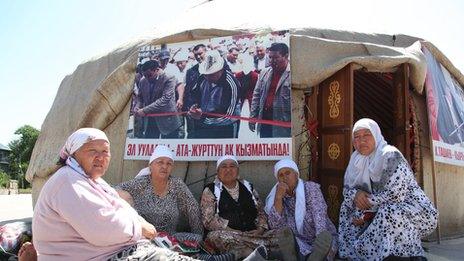What is driving Kyrgyzstan's protest culture?
- Published

Near a traditional yurt, several elderly Kyrgyz women are sitting and sorting through children's clothing for sale. They are not traders. They call themselves mother-heroines and they are one of the driving forces of protest in the southern city of Jalalabad.
These mother-heroines have occupied the square in front of the office of the regional governor on and off since last October. They are demanding the release of three opposition MPs arrested over an alleged attempt to topple the government during a mass rally.
Just a few days ago their supporters stormed a Jalalabad local government building, forcing the regional governor to flee. They also blocked the only highway that links northern Kyrgyzstan with the south.
Such protests have become a daily routine in Kyrgyzstan. According to Prime Minister Jantoro Satybaldiev, there were 1,286 protests across Kyrgyzstan in 2012. That means on average ,there were more than three protests a day.
Farmers, truck drivers, casino owners, land grabbers, traders, policemen - people from all walks of society are increasingly trying to solve their problems by taking to the streets. Tired of protests, several hundred people held a demonstration against demonstrations in Bishkek earlier this year.
Medet Tiulegenov, a political analyst from the American University in Central Asia, said a lack of trust in the government meant people readily took to the streets.
"Formal mechanisms to communicate with the authorities are weak or completely absent," he said. "So street protests are often the only option."
'The people'
This protest culture has been shaped by two mass uprisings in Kyrgyzstan in recent years. In 2005 and again in 2010, mobs captured the White House, where the government sits, and ousted the ruling president.
This has led to a situation today in which a mob of a few hundred people, some perhaps paid to participate by interested parties, can "appoint" their governors, directors and other state officials. The government normally does not recognise the "people's" appointee, but they cannot ignore the mood on the ground either.
Earlier this year, for example, a new police chief in the mountainous Naryn region had to flee his office after local residents and police officers unhappy with his appointment stormed the police department building. Although the government insists the chief remains its preferred candidate, he has not returned to his office yet.
And each mass rally becomes an example for others to follow.
"President [Almazbek] Atambayev came to power through mass protests. He also seized the White House. So why can't we protest as well?" said Anarkhan Dehkanova, one of the mother-heroines, referring to the 2010 uprising and in response to the suggestion that the law was broken when the Jalalabad governor was ousted.
Amid this growing protest culture, the new government frequently uses the word el - "the people" - in its slogans to emphasis its claim to public legitimacy. One of the slogans on the website of the Interior Ministry reads: "Together with the people and for the prosperity of our Fatherland."
Police are also finding it hard to disperse demonstrators even if they are breaking the law. In Jalalabad, police watched the protesters as they blocked the highway - causing a massive traffic jam and serious economic losses for local businesses.
"There were not just young men there," said Almazbek Malabekov, police chief of the district where the road was blocked. "There were elderly men and women too. If we used force to disperse them, the situation would only have got worse."
'Soft approach'
Peaceful demonstrations can, however, turn violent. Last month protesters in the Issik Kul region denouncing a gold mining deal clashed with police. The government was forced to announce a state of emergency in the area to end the mass disturbances.
To end the cycle of street protests and boost the rule of law, the government needs to punish those who break the laws, Mr Tiulegenov said.
"It's important not to create the feeling of impunity that encourages protesters to be more radical. But it's also important to combine negotiations and a soft approach," he said.
Dr Erica Marat, a Central Asia expert, says that the government should also try to include opposition leaders in a political process and strengthen local government.
"Improving capacity and professionalism of the local government would enable them to respond to the very local issues people [protest about] and prevent mobilization of aggressive mobs," she said.
Back in Jalalabad, several protesters remain on the square. Empty yurts are meant to indicate that a crowd could be gathered at any moment.
They are threatening to block the highway again if their demands are not met. As the Central Asian summer gets hotter, the protesters may take a break. But they will be back in the autumn.
- Published24 March 2023
- Published1 June 2013